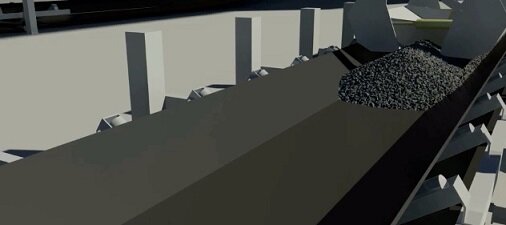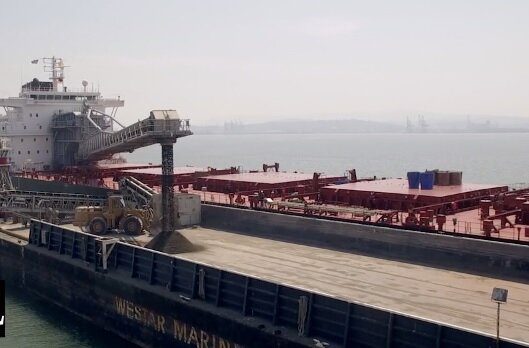

Home ||| Bulk Cargo ||| Planning ||| Care ||| Safety||| Self unloaders
Self- unloading bulk carriers objective of gate operations, gate problems & crew responsibilities

Self unloading bulk carrier features a space-saving gate under the hold and a fully enclosed boom conveyor. The company explains that cargo gates are the first element of a ship's gravity unloading system, and allow the cargo to fall on to the conveyor belt running below the cargo holds in a controlled manner. The boom conveyor is the final element of a ship's bulk self-unloading system, transferring the cargo to a shore based or marine facility.

Fig: Self unloader gate-opened carrying cargo
Gate operation objectives
- To identify the gate for the hold that it serves.
- To maintain a steady discharge, at the rate required.
- To prevent overloads and spillages.
- To ensure the careful operation of the gates.
The following factors are to be taken into account:
- Type/design of the gate.
- Flow ability of the cargo.
- The rate set by Cargo Control Room indicated by the traffic lights.
- Correct operating pressure in the lines.
- Stage of discharge, i.e. level of cargo in the hold.
- Any dangerous build up of cargo in the hold.
- Its distance from the transfer area, the further away the more the belt is loaded, and the chances of overload are therefore greater.
The sluice type gates drop the cargo onto the belt, whilst the bucket jaw type tends to lay the cargo onto the belt in the direction of its travel. Care must be taken not to dump the cargo onto the belt, as this will cause a spillage. The gate should be opened by jerking it partly at first, and the incremental stages, watching the traffic lights at all times. As the belt travels with the load, the light may suddenly turn to red in which case start closing the gate. If the red light remains on, close the gate and re-open it when the light returns to amber, then set that flow.
There will be a time lag between the lights, and the increase or decrease of cargo allowed on the belt. The traffic lights must be watched all the time and kept safely on the amber light, between red and amber nearer the transfer area, and to between amber and green away from the transfer area. If the red light tends to remain, reduce the flow immediately. The time taken for the load sensors to sense the change in load must be borne in mind.

Fig: Self unloader discharging onto barge
To maintain a steady rate of discharge, before changing gates, it may be prudent to jerk a trickle from the next gate to ensure that it will flow when required.
Means of communication must be tested taking the noise levels in the tunnel into consideration. The tunnel light and sound signals code must also be understood by all Gate Operators.
Directing gate operators
When directing the Gate Operator: at the start-up during the dipping stage, and when lightening a vessel for low water, it is imperative that the Chief Officer controls the gates to be used, to effect an even-keel bodily rise of the vessel.
During the main discharge, the Gate Operators are to follow the sequence on the discharging plan, and their movements are to be reported to the Cargo Control Room and the Duty Officer. The Duty Officer is to monitor the movements of the Gate Operators and ensure compliance to the discharging plan. It is the cargo itself, that helps the cargo to slide. With gypsum, the lumps and stones slide over the fines and bring down the fines with them. Cargoes such as aggregate of stone, iron ore or pellets, and coal have a good flow ability.
When the cargo flow is erratic, the Gate Operators must be cautious for sudden cargo slides which will shoot past the gate, and cause an overload/spillage. The Duty Officer must warn the tunnel of any such tendency or build-up in the hold, which could fall onto the open gate. When using the Vibrators never open the gate fully, as the cargo may fall suddenly. When moving to the next gate it is essential that the previous one is closed and isolated.
During draining, the Duty Officer is to guide the Operators by hold and gate number. The draining of hold gates is to be carried out methodically, and assisted by the use of Vibrators if necessary. The method of draining a hold has to be perfected by practice, and the knowledge of the flow-ability of the cargo.
Gate problems
The vessel is to detail the ship specific actions taken if the following problems occur:-
- Gate blockage
- Gate off track
- Loss of gate power
- Foreign object in way of a Gate
- Actuation of the Emergency Stops
These actions are to be documented and explained at meetings.
Crew duties
The Master, Chief Engineer and Chief Officer must liase closely before and during the unloading operations.
As the operation is highly mechanised Cthheie f Engineer is more involved in cargo operations than on a conventional vessel. As a result the actual operation of the unloading system falls directly under his control.
The Deck Department are to provide an unloading plan which will state the sequence of ballasting operations.
The Tunnelmen and Electrician(s) are primarily responsible for the operation of the unloading equipment, however during long unloading periods it is necessary to draft in Crew from other departments. It is therefore necessary to train personnel from the Deck and Engine departments, mainly the Ordinary Seaman and including Cadets, to operate the tunnel gates and maintain a watch during unloading. This will allow the unloading equipment to be operational for extended periods whilst complying with the STCW regulations regarding crew working hours.
In the case of long discharges it will be necessary to split the tunnelmen into two teams, in order that they can monitor the operation of the unloading equipment, whilst other personnel operate the gates. One Tunnelman is to walk-round the entire system once an hour, while the other Tunnelman remains in the tunnel operating the gates, and overseeing crew from other departments.
The duty Deck Officer is to maintain an effective cargo watch, which is to include orders for ballasting operations, and the maintenance of the vessel in an up-right condition. The Boom must be kept clear of the cargo pile at all times, and one man must be stationed at the boom controls during the entire discharge period, to attend to adjustments.
Overloads and spillage's
Common causes for spillages: If the cargo is comprised mainly of fines, these may pass through the scrapers and cause a gradual build-up of cargo in the vicinity of pulleys. To minimise this, the belt cleaners or scrapers that are not functioning correctly, must be adjusted or replaced.
Spillage and resultant overload can be caused when the cargo suddenly slides through an open gate and therefore Gate Operators must remain alert. Warnings of sudden cargo slides must be given by the Duty Officer. Cargo may bounce off the running belt, especially in the case of a mass-flow gates, and if not checked, may damage the undercarriage.
The gates must be operated with great care and should any cargo fall onto the underside, the belt must be stopped. Blunt long-handled rakes are provided to remove such fallen cargo, and the utmost care must be taken while using these. Material spillage from the Loop belt may be as a result of the following:
- Incorrect belt alignment.
- Low belt tension.
- Nominated Charter Party cargo lump size exceeded.
Trash pumps operation
The Trash Pumps are provided at the tunnel bilge wells, and are also capable of pumping out slurry. Care must be exercised whilst using them, to avoid damage to their impellers by trying to force cargo, such as stone or iron ore pellets through them.
If for some reason water has accumulated inside the tunnel during discharging, it must be established that this water does not contain cargo residue, or any trace of oil.
Bulk carrier types |||
Cargoes that may liquefy |||Suitability of ships |||Terminal guideline |||
Bulk carrier safety |||Fire fighting systems |||Bulk carrier General arrangement
Our detail pages illustrated many safety aspects of Bulk carrier
Home page |||Bulk carrier types ||| Handling of bulk coal |||Cargo planning ||| Carriage of grain |||Risk of iron ores |||Self unloading bulk carriers |||Care of cargo & vessel |||Cargoes that may liquefy |||Suitability of ships |||Terminal guideline |||Hold cleaning |||Cargo cranes |||Ballast handling procedure |||Bulk carrier safety |||Fire fighting systems |||Bulk carrier General arrangement
Related information
-
Self unloader components
-
Function of loop & bucket belt elevators
-
Self unloaders various cargo handling gears
-
Various type boom conveyor belts - How the belt sytem practically works ?
-
Dealing with self unloaders stalled lift belt
-
Conveyor belt construction & troubleshoot guide
-
Conveyor belt installation guide
-
Conveyor belt repair & maintenence guide
-
Safe working practice onboard self unloading bulk carriers
-
Preventing conveyor belt fire onboard self unloading bulk carriers
-
Cargo work safety precautions
-
Various bulk cargoes - free flow ability
-
Various bulk cargoes & dealing with cargo hang ups
-
Navigation in Ice & safety precautions
-
Dust suppression procedure & environment protection
-
Preparations for cargo planning, handling & stowage
-
Maintaining safe stability onboard self-unloading bulk carriers
-
Procedure for bulk cargo handling prior to and during loading
-
Loading operations - voyage orders, draft restrictions, various grades and rates
-
Loading sequence and other related considerations
-
Preparations for discharging & related guideline
-
Self unloaders discharging operation
-
Safety precautions for boom operation
-
Cargo holds/ tunnels cleaning, maintenance and check items
-
Procedure for transporting coal on self- unloading bulk carriers

Operation of sea going bulk carriers involved numerous hazards . Careful planning and exercising due caution for all critical shipboard matters are important . This site is a quick reference to international shipping community with guidance and information on the loading and discharging of modern bulk carriers so as to remain within the limitations as specified by the classification society.
It is vital to reduce the likelihood of over-stressing the ship's structure and also complying with all essential safety measures for a safe passage at sea. Our detail pages contain various bulk carrier related topics that might be useful for people working on board and those who working ashore in the terminal. For any remarks please Contact us
Copyright © 2010 bulkcarrierguide.com All rights reserved.
Although every effort have been taken to improve the accuracy of content provided the publisher of this website cannot take responsibility for errors. Disclaimer Privacy policy Home page



